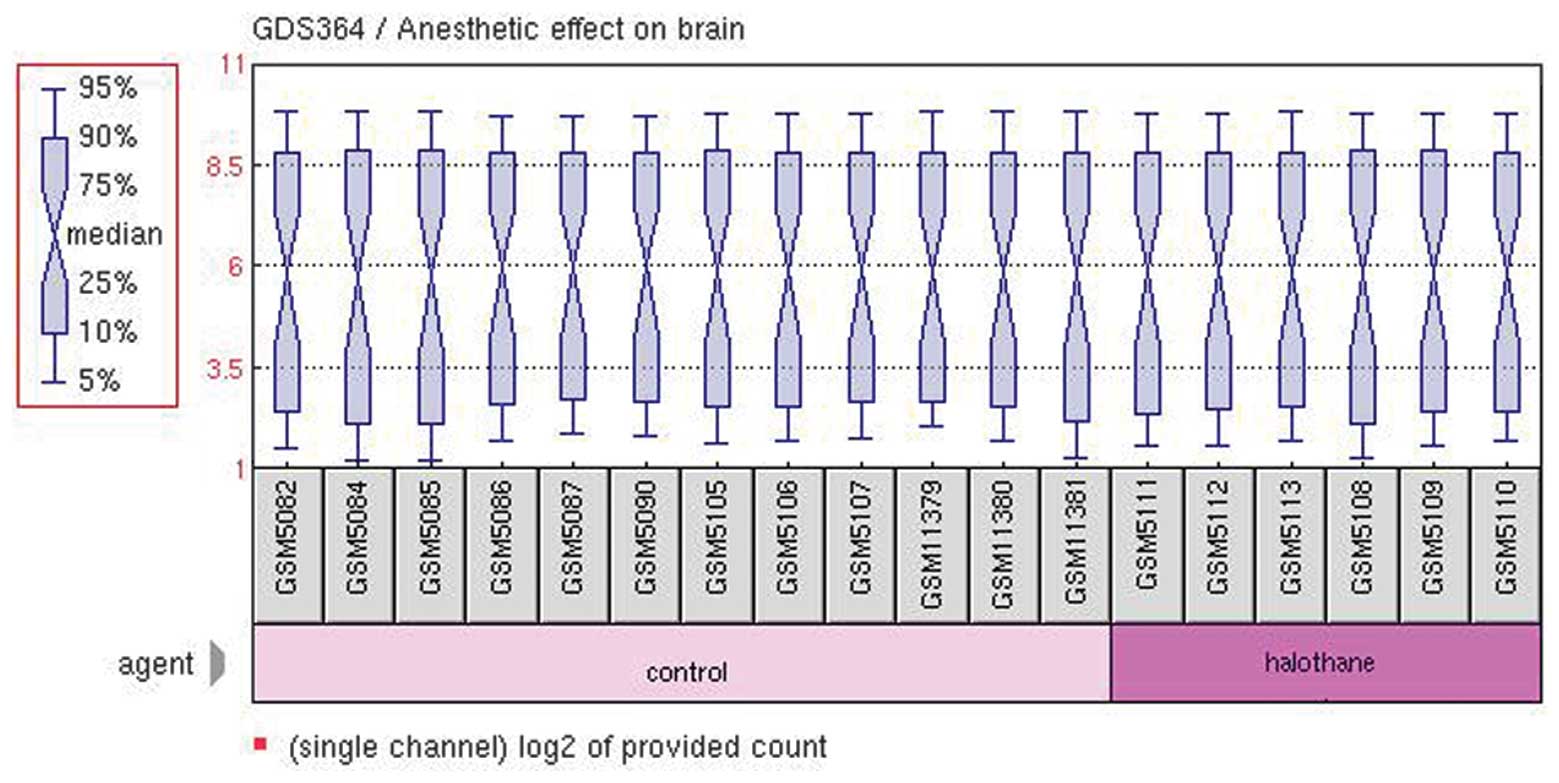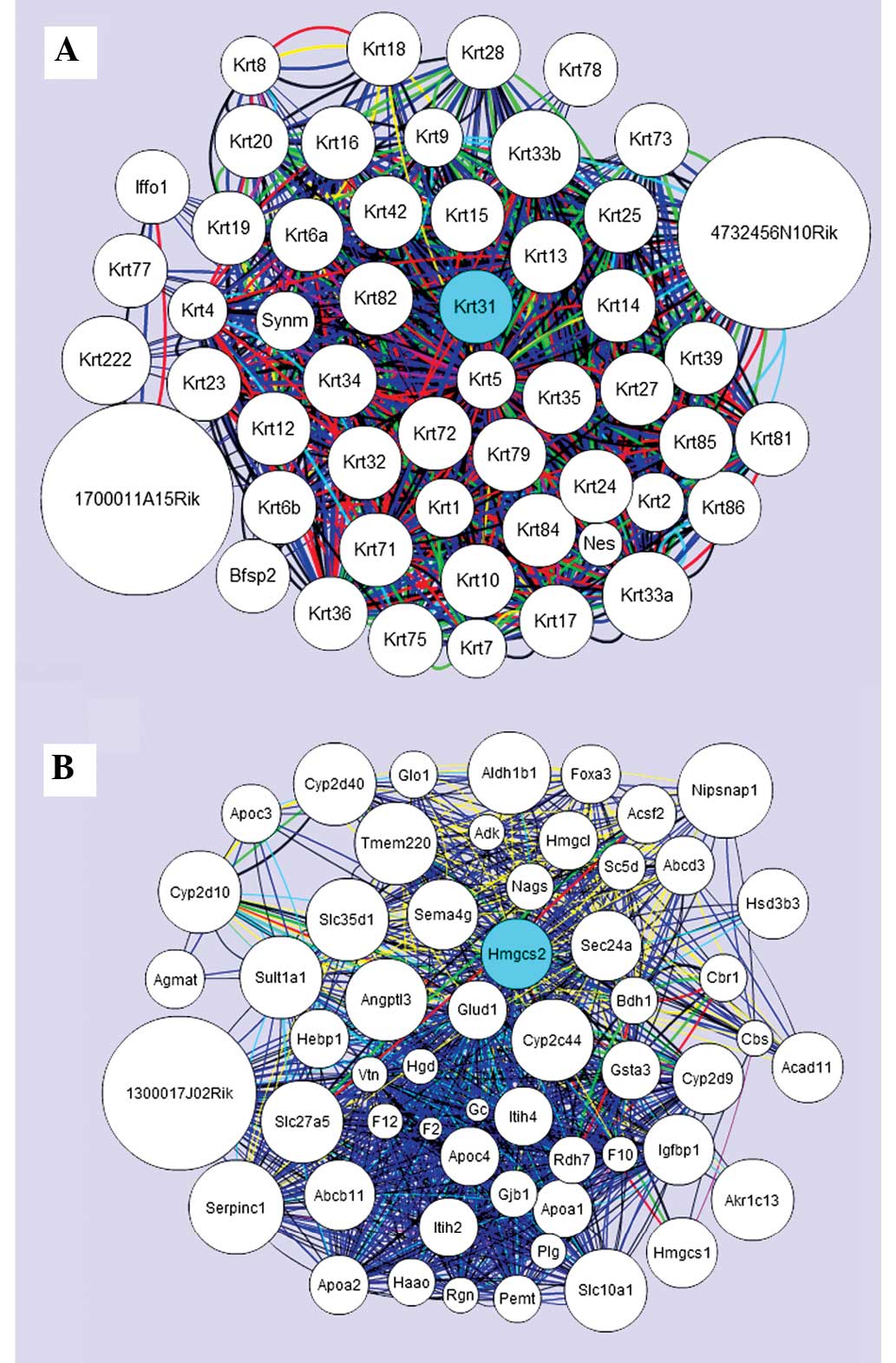|
1
|
Weiser TG, Regenbogen SE, Thompson KD, et
al: An estimation of the global volume of surgery: a modelling
strategy based on available data. Lancet. 372:139–144. 2008.
View Article : Google Scholar : PubMed/NCBI
|
|
2
|
Eger EI 2nd and Sonner JM: Anaesthesia
defined (gentlemen,this is no humbug). Best Pract Res Clin
Anaesthesiol. 20:23–29. 2006. View Article : Google Scholar : PubMed/NCBI
|
|
3
|
Richter J, Landau EM and Cohen S: The
action of volatile anesthetics and convulsants on synaptic
transmission: A unified concept. Mol Pharmacol. 13:548–559.
1977.PubMed/NCBI
|
|
4
|
Alkire MT, Pomfrett CJ, Haier RJ, et al:
Functional brain imaging during anesthesia in humans: effects of
halothane on global and regional cerebral glucose metabolism.
Anesthesiology. 90:701–709. 1999. View Article : Google Scholar : PubMed/NCBI
|
|
5
|
Matsumoto N, Koizumi M and Sugai M:
Hepatolobectomy-induced depression of hepatic circulation and
metabolism in the dog is counteracted by isoflurane, but not by
halothane. Acta Anaesthesiol Scand. 43:850–854. 1999. View Article : Google Scholar : PubMed/NCBI
|
|
6
|
Harrfeldt HP: Acute liver failure
following repeated halothane anesthesia-related to an accident
covered by industrial insurance. Monatsschr Unfallheilkd Versicher
Versorg Verkehrsmed. 72:3171969.In German.
|
|
7
|
Lo SK, Wendon J, Mieli-Vergani G and
Williams R: Halothane-induced acute liver failure: continuing
occurrence and use of liver transplantation. Eur J Gastroenterol
Hepatol. 10:635–639. 1998.PubMed/NCBI
|
|
8
|
Wessler S: Halothane and liver failure.
JAMA. 213:1291970. View Article : Google Scholar : PubMed/NCBI
|
|
9
|
Hemmings HC Jr, Akabas MH, Goldstein PA,
Trudell JR, Orser BA and Harrison NL: Emerging molecular mechanisms
of general anesthetic action. Trends Pharmacol Sci. 26:503–510.
2005. View Article : Google Scholar : PubMed/NCBI
|
|
10
|
Nishikawa K, Jenkins A, Paraskevakis I and
Harrison NL: Volatile anesthetic actions on the GABAA receptors:
contrasting effects of alpha 1 (S270) and beta 2 (N265) point
mutations. Neuropharmacology. 42:337–345. 2002. View Article : Google Scholar : PubMed/NCBI
|
|
11
|
Gomez RS, Guatimosim C and Gomez MV:
Mechanism of action of volatile anesthetics: role of protein kinase
C. Cell Mol Neurobiol. 23:877–885. 2003. View Article : Google Scholar
|
|
12
|
Hemmings HC Jr and Adamo AI: Effects of
halothane and propofol on purified brain protein kinase C
activation. Anesthesiology. 81:147–155. 1994. View Article : Google Scholar : PubMed/NCBI
|
|
13
|
Maingret F, Patel AJ, Lesage F, Lazdunski
M and Honoré E: Mechano- or acid stimulation, two interactive modes
of activation of the TREK-1 potassium channel. J Biol Chem.
274:26691–26696. 1999. View Article : Google Scholar : PubMed/NCBI
|
|
14
|
Eckenhoff RG and Shuman H: Localization of
volatile anesthetic molecules at the subcellular and molecular
level. Ann N Y Acad Sci. 625:755–756. 1991. View Article : Google Scholar : PubMed/NCBI
|
|
15
|
Xi J, Liu R, Asbury GR, Eckenhoff MF and
Eckenhoff RG: Inhalational anesthetic-binding proteins in rat
neuronal membranes. J Biol Chem. 279:19628–19633. 2004. View Article : Google Scholar : PubMed/NCBI
|
|
16
|
Chepovetsky J, Kalir T and Weiderpass E:
Clinical applicability of microarray technology in the diagnosis,
prognostic stratification, treatment and clinical surveillance of
cervical adenocarcinoma. Curr Pharm Des. 19:1425–1429. 2013.
|
|
17
|
Pan JZ, Wei H, Hecker JG, Tobias JW,
Eckenhoff RG and Eckenhoff MF: Rat brain DNA transcript profile of
halothane and isofurane exposure. Pharmacogenet Genomics.
16:171–182. 2006.PubMed/NCBI
|
|
18
|
Xia X, Mcclelland M and Wang Y: WebArray:
an online platform for microarray data analysis. BMC
Bioinformatics. 6:3062005. View Article : Google Scholar : PubMed/NCBI
|
|
19
|
Fernandez P, Soria M, Blesa D, et al:
Development, characterization and experimental validation of a
cultivated sunfower (Helianthus annuus L.) gene expression
oligonucleotide microarray. PLoS One. 7:e458992012. View Article : Google Scholar
|
|
20
|
Ashburner M, Ball CA, Blake JA, et al:
Gene ontology: tool for the unification of biology. The Gene
Ontology Consortium. Nat Genet. 25:25–29. 2000. View Article : Google Scholar : PubMed/NCBI
|
|
21
|
Brown DL and Brock-Utne JG: The first
structure-function approach to drug design in anaesthesia. Dr David
S Savage and pancuronium bromide. Anaesthesia. 52:1202–1204. 1997.
View Article : Google Scholar
|
|
22
|
Quentien MH, Delemer B, Papadimitriou DT,
et al: Deficit in anterior pituitary function and variable immune
deficiency (DAVID) in children presenting with adrenocorticotropin
deficiency and severe infections. J Clin Endocrinol Metab.
97:E121–E128. 2012. View Article : Google Scholar
|
|
23
|
Beaver JE, Tasan M, Gibbons FD, Tian W,
Hughes TR and Roth FP: FuncBase: a resource for quantitative gene
function annotation. Bioinformatics. 26:1806–1807. 2010. View Article : Google Scholar : PubMed/NCBI
|
|
24
|
Shakouri P, Ordys A and Askari MR:
Adaptive cruise control with stop & go function using the
state-dependent nonlinear model predictive control approach. ISA
Trans. 51:622–631. 2012. View Article : Google Scholar : PubMed/NCBI
|
|
25
|
Wang J, Zhou X, Zhu J, et al: GO-function:
deriving biologically relevant functions from statistically
significant functions. Brief Bioinform. 13:216–227. 2012.
View Article : Google Scholar
|
|
26
|
Wright J, Morales MM, Sousa-Menzes J, et
al: Transcriptional adaptation to Clcn5 knockout in proximal
tubules of mouse kidney. Physiol Genomics. 33:341–354. 2008.
View Article : Google Scholar : PubMed/NCBI
|
|
27
|
Medzhitov R and Janeway C Jr: Innate
immune recognition: mechanisms and pathways. Immunol Rev.
173:89–97. 2000. View Article : Google Scholar : PubMed/NCBI
|
|
28
|
Park JS, Svetkauskaite D, He Q, et al:
Involvement of Toll-like receptors 2 and 4 in cellular activation
by high mobility group box 1 protein. J Biol Chem. 279:7370–7377.
2004. View Article : Google Scholar
|
|
29
|
Dugan CM, Fullerton AM, Roth RA and Ganey
PE: Natural killer cells mediate severe liver injury in a murine
model of halothane hepatitis. Toxicol Sci. 120:507–518. 2011.
View Article : Google Scholar : PubMed/NCBI
|
|
30
|
Scaffidi P, Misteli T and Bianchi ME:
Release of chromatin protein HMGB1 by necrotic cells triggers
inflammation. Nature. 418:191–195. 2002. View Article : Google Scholar : PubMed/NCBI
|
|
31
|
Nyirenda MJ, Lind say RS, Kenyon CJ,
Burchell A and Seckl JR: Glucocorticoid exposure in late gestation
permanently programs rat hepatic phosphoenolpyruvate carboxykinase
and glucocorticoid receptor expression and causes glucose
intolerance in adult offspring. J Clin Invest. 101:2174–2181. 1998.
View Article : Google Scholar : PubMed/NCBI
|
|
32
|
Agresti A, Scaffidi P, Riva A, Caiolfa VR
and Bianchi ME: GR and HMGB1 interact only within chromatin and
influence each other's residence time. Mol Cell. 18:109–121. 2005.
View Article : Google Scholar : PubMed/NCBI
|
|
33
|
Loranger A, Duclos S, Grenier A, et al:
Simple epithelium keratins are required for maintenance of
hepatocyte integrity. Am J Pathol. 151:1673–1683. 1997.PubMed/NCBI
|
|
34
|
Asch HL, Mayhew E, Lazo RO and Asch BB:
Lipids covalently bound to keratins of mouse mammary epithelial
cells. Biochem Mol Biol Int. 29:1161–1169. 1993.PubMed/NCBI
|











